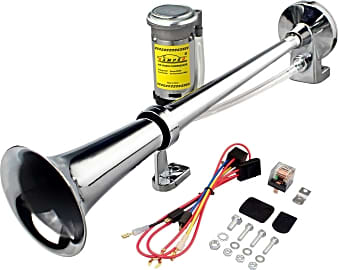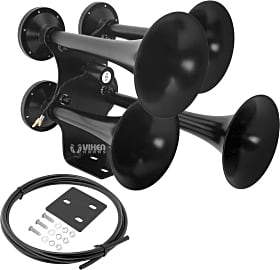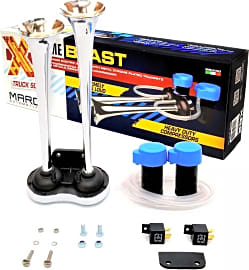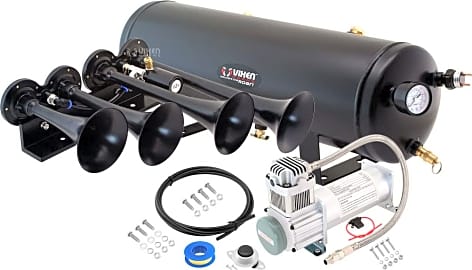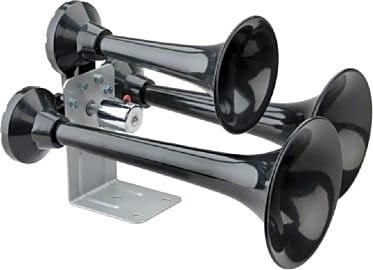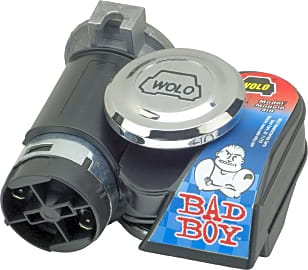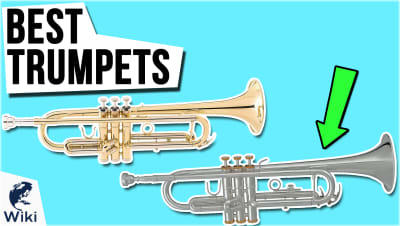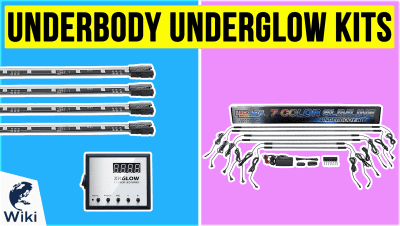The 10 Best Air Horns For Trucks

This wiki has been updated 32 times since it was first published in April of 2017. Some circumstances don't allow for subtlety or nuance, particularly when driving a large truck at high speeds. While yelling isn't a very effective way to get the attention of other motorists on the road, you can be confident that one of these air horns is. We've included a variety of models that simulate the deep and resonant tones produced by ambulances, fire engines, and trains. When users buy our independently chosen editorial choices, we may earn commissions to help fund the Wiki.
Editor's Notes
December 04, 2020:
As mentioned previously, exercising common sense and safety is still paramount when installing one of these air horns onto your vehicle. Be aware of those around you, use them at your discretion within reason, and always drive responsibly.
Newly added this year is the Gampro Single Trumpet due to its affordable price point and redesigned compressor with a copper coil and vacuum chrome plating. This one also comes with an 80-amp safety relay.
Albeit pricey, we've also included the powerful Vixen Train Kit for its 200-PSI output, three-gallon air tank, sturdy leader hose with check valve for preventing backflow and leakage, and integrated thermal overload protection.
Thanks to its compact design, the Marco Tornado is a good option for small vehicles and it can also maintain its performance in temperatures as low as zero degrees Fahrenheit.
August 29, 2019:
Always check your state's vehicle code to make sure the horn you choose is legal for use on the streets and highways. Use discretion, as these things get pretty darn loud, so they should only be used when necessary and not as a means of taunting or scaring other drivers for fun.
If you've ever driven a large truck, you're probably aware of all the noise and commotion around you. Drivers will change lanes without signaling, they might try to cut you off, and it's almost certain that they'll honk to make themselves heard. When you add high-velocity truck travel into the equation, you'll need something more than a conventional car horn to get your point across to those other drivers. Think air horn, but on a larger and louder scale and with a specific purpose of making your presence known amidst a sea of smaller vehicles. Since a truck is generally loud on its own, you'll need an air horn designed specifically for that vehicle that's capable of producing enough sound to carry over all that other noise. Our list includes several models that simulate the sounds coming from fire engines, ambulances, and even train horns.
For example, the three chrome-plated brass trumpets on the Grand General Heavy Duty produce a sound reminiscent of the horn from a large locomotive at more than 140 decibels. I also added the Wolo Chief for its slender design and front pedestal for reducing vibrations when driving at high velocity. As one of the least expensive options, the Zento Single is compatible with a variety of vehicles and comes with everything you need to make your truck heard, including a powerful, bright red air compressor. The stacked design of the Vixen Quad not only looks cool, but the all-metal construction allows it to withstand extreme weather conditions. I also included the Kleinn HK2 for its half-gallon air tank, 30-second sound blast, and ease of installation under most hoods. The one-piece design of the Wolo Bad Boy eliminates the need for additional hose attachments, while the compact size allows it to fit inside most engine compartments. The Marco Extreme Blast is one of the few options that comes with dedicated air compressors for both of its horns, and it can also be installed in most cars and SUVs. Finally, the ABS construction on the Wolo Siberian Express provides a lightweight design and dependable rust resistance, while its long horns deliver a deep and rich tone.
Special Honors
HornBlasters Ultimate Nathan Airchime Made from die-cast aluminum with stainless steel diaphragms, the massive HornBlasters Ultimate Nathan Airchime kit gives a genuine train horn a run for its money. Equipped with a 12-gallon air tank and eight ports, this one delivers a maximum working pressure of 150 PSI and burst rating of up to 300 PSI, giving you enough capacity to blast the horns continuously for up to 10 seconds. It also comes with four compressors that can recharge the tank in less than three minutes. Additional accessories include an electric drain valve kit for removing condensation from the tank remotely, air relocation kit for inflating tires and toys, wireless horn activation remote, and a digital pressure gauge. hornblasters.com
Air Horns: Honking Under Pressure
While this is certainly useful for the typical consumer automobile, it's equally important that trucks be equipped with similar accessories due to their size.
We live in a pretty noisy world, which is true both in figurative and literal terms. When loud sounds are purposefully emitted, they convey many different meanings to those around them. Music, for example, is a collection of seemingly-random sounds that, when played together, form a harmony that is pleasing to the ears and used to express feelings and emotions of the composer or listener. That said, sound plays an important psychological role in the way the world is perceived. Sound can also be used as a tool to alert people to potential danger or just let someone know you're there. For example, anyone who's been stuck in traffic at rush hour knows that drivers love to honk their horns as a way of expressing the anger and frustration associated with their predicaments. Horns can also be used to prevent potential accidents from occurring on the road. While this is certainly useful for the typical consumer automobile, it's equally important that trucks be equipped with similar accessories due to their size.
While an accessory like an underbody underglow kit is used to draw attention to a vehicle in the stylish sense, the air horn serves a more practical function by improving road safety. The air horn is a pneumatic device that emits an extremely loud sound for the purpose of signaling and alerting other drivers to a vehicle's presence. Similar in shape to a trumpet, the air horn uses compressed air to vibrate a diaphragm located inside a compression chamber within the device. This combination of components ensures instant sound when the horn is activated by a switch or button inside a vehicle. Once activated, a valve inside the horn's compression chamber opens, allowing compressed air to escape from the base (or throat). As this occurs, the diaphragm also begins to vibrate, resulting in the production of high-pressure sound waves. These sound waves travel from the narrow portion of the throat to the wide, flared mouth of the device where they are ultimately amplified and passed through and out of the horn's bell.
Many air horn kits are equipped with multiple "trumpet" pieces capable of emitting loud sounds of varying frequencies. The term "trumpet" is loosely used to describe a horn's resemblance to the musical instrument, but I wouldn't recommend installing a trumpet on top of your truck. Being that not every large truck has a built-in air compressor, a truck's air horn will instead operate via the vehicle's air brake system. This means that a truck driver can run a ceiling-mounted cord inside the vehicle, which can be pulled to open a valve on the truck's airline leading to the roof-mounted horns outside. Anyone who's ever taken a family road trip has probably experienced the fun of watching their children motion to a nearby truck driver in the hopes that he'll pull the sound cord attached to his roof-mounted horns to make that iconic noise.
Most air horns for trucks operate in a range between 110 to over 150 decibels. Given that the quietest sounds detected by the human ear reach as low as 10 decibels, 150 is pretty darn loud! Depending on their overall length, air horns produce sound waves at either high or low frequencies (also known as pitch). High-frequency audio waves are more compressed and travel shorter distances, resulting in a higher pitched sound. By contrast, low-frequency waves travel greater distances and deliver a deep, low-pitched sound.
Tooting Your Own Horn
Superior sound projection and appropriate volume are among the most important considerations for a truck's air horn. To get the necessary attention, you'll want a well-defined sound that anyone within earshot can quickly recognize. The length and shape of a horn's bell will determine its level of acoustic resonance upon sound amplification. Consider a kit that comes equipped with two or more bells, allowing your horn to produce a harmony of different frequencies. Aside from making it easy to hear, a horn with multiple bells sets your truck apart from others on the road with its unique tones.
An air horn's level of air pressure is directly proportional to its volume output.
Always be aware of the amount of pressure a horn's air compressor is capable of producing. An air horn's level of air pressure is directly proportional to its volume output. The compressor should be able to generate pressure upwards of 120 pounds per square inch. That said, if you anticipate being on the road during times of extremely heavy traffic, a loud horn will prove beneficial when trying to get the attention of other motorists.
You should determine the necessary compressor duty cycle, which defines how often the horn can be used before the compressor needs to rest. A compressor duty cycle of ten percent delivers up to six minutes of sustained honking per hour. Depending on the type of situations in which you find yourself, a higher duty cycle may be warranted.
While pressure and volume output are important, you'll also want to keep overall air capacity in mind. The larger the air tank, the longer a horn's sound can be sustained. Many air horn kits come with tanks that store up to half a gallon of air for continuous honking.
A Very Brief History Of Air Horns
Noted for its ahooga sound, the Klaxon was one of the earliest automobile horns first patented in 1908 by Miller Reese Hutchison, an avid inventor who later became chief engineer for Thomas Edison’s laboratory in West Orange, New Jersey.
When diesel locomotives replaced steam-powered trains by the middle of the 20th century, they were equipped with early truck-made air horns as an alternative to the steam whistle. The first freon-powered, dual-trumpet air horns appeared in 1945, thanks to boating enthusiast Harold Hadley.
Modern air horns for trucks offer filters to keep out dirt and humidity, corrosion-resistant designs that help extend their operating lives, and very power-efficient operation without the electromagnetic interference found in their predecessors.


